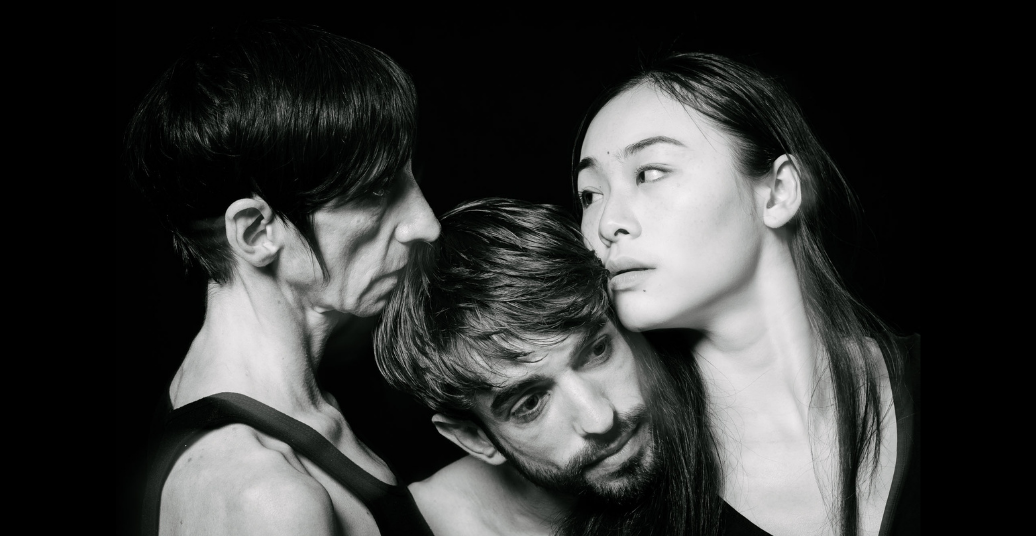Laborgras presents “sinnestaumel” at the St. Elisabeth Church from 11 to 14 November 2021, as part of the “Early Music & Contemporary Dance” cycle, which began in 2020 within the Tetra Bach – Four Positions on Bach series initiated by Folkert Uhde Konzertdesign. “sinnestaumel” is an elegant piece that speaks to the senses through a beautiful movement score in empathy with the music. Three dancers — Abraham Iglesias Rodriguez, Tian Gao, and Renate Graziadei together with Midori Seiler on the violin and Christian Rieger on the harpsichord — maintain a continuous one-hour dialogue with Bach’s Six Sonatas for Violin and Harpsichord, BMV 1014-1019.
The audience at the St. Elisabeth Church is positioned on three raised platforms on three sides, the musicians on the left, and the dancers in the central space, which has a pale wooden floor. On the right-hand side is a used sofa which forms part of the stage design together with a huge mirror hanging on the wall. Another set of mirrors leanes on the apse wall, following its semi-circular path.
From the very beginning I have an impression of delicate balance — one which recurs throughout the entire piece: In the half-light, first the musicians and then the three dancers enter, positioning themselves in a triangle at the centre of the stage. The movement sequence begins in softness. From their places in the triangle, they pass their breath to one another and I receive an image of air. This airy sensation stays with me until the end of the piece.
The movement score is a flourishing and flowing blending of duets, solos, and trios written into a composition where music and dance are constantly as one. There are moments of togetherness and comic joy when the trio is together on the sofa. Other moments are determined by quick and vibrating moments, or are more intimate and meditative, such as when the trio dance faces the mirrored wall of the apse. Still other trios are highly energetic and sharp, while the duet between Renate Graziadei and Abraham Iglesias Rodriguez looks to me like a dynamic melting of two bodies. The movement of the dancers keeps altering my perception of the space — through a very clear and conscious writing of the body in the space. I feel sudden expansions and then moments that curl into themselves. This feeling is heightened by Emma Juliard’s strategically placed light design with its very specific positioning on the windows of the apse, and the way in which the warm side lights transform into an open and cold light at the centre of the stage. The use of mirrors is also engaging. At times they multiply the dancers, while at others, they create a personal place of solitude.
The rich and articulate movement language comprises shifting weight, spiralling of the body, rapid body transfers in the space, walking, and complex movement patterns which echo from dancer to dancer. Their recurrence is the way in which the piece evolves. The costumes, perfectly designed by Claudia Janitschek, highlight these repetitions in soft black fabric, with pants and shirts uniquely cut for each of the three performers. I feel that laborgras succeeds in writing with the body through the music and recognises the extent to which the music of Bach is still a current, persistent, and present agent in contemporary dance.
I recently read a review by Italian dance critic Stefano Tomassini on The Goldberg Variation, BWV 988, which was the latest piece by Belgian choreographer Anne Theresa De Keersmaeker, and another piece by the Compagnia Zappalà Danza. Both choreographers work compositions by Bach. Tomassini writes that: “the surprising vitality of Bach’s music (…) reveals all it’s most necessary topicality: the process, exercise, and practice as non-coercive capacities of the imagination”*. I can’t agree more. In this work, laborgras appears to have developed a constant practice of sensing the music. Even though the movements are seemingly defined to the nearest millimetre and the trios move in perfect synchronicity with the music, their bodily awareness and accuracy allows me to perceive, for example, the precise position of a hand on a scapula before a lift, or the delicate yet rigorous movement of fingers cutting through the air. It seems clear to me that the dancers’ bodies know what to do to the point that each gesture they perform is etched into them.
I personally consider a pure dance score as a structured and embodied language with which dancers are capable of engraving the space with their bodies — something that seems to be lacking so often in performances these days. This work reminds me how much the political agenda of a body is expressed through its ability to speak for itself and in acknowledging movement as a source of empowerment for the senses and our perception, both as performers and audience members.
“sinnestaumel” premiered on 11 November 2021, running until 14 November 2021 at St. Elisabeth Church (Invalidenstr. 3, 10115 Berlin), more information on the company’s website www.laborgras.com.
Concept and Artistic Direction: laborgras. Artistic Collaboration: Barbara Weigel. Choreography: laborgras in Collaboration With Abraham Iglesias Rodriguez and Tian Gao. Performance: Abraham Iglesias Rodriguez, Tian Gao, Renate Graziadei. Violin: Midori Seiler. Harpsichord: Christian Rieger. Dramaturgy: Arthur Stäldi. Costume Design: Claudia Janitschek. Technical Direction and Lighting Design: Emma Juliard. Production: Inge Zysk and Raquel Moreira.
Music: Johann Sebastian Bach – Six Sonatas for Violin and Harpsichord, BWV 1014-1019, from this the sonatas BWV 1014, 1017 & 1019.
*References: Stefano Tomassini (2021), Zappalà e De Keersmaeker: disfare la musica e rifare il mondo, con Bach, ‘Teatro e Critica’ (12.11.2021), translation by the author.




